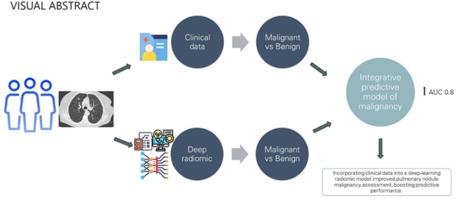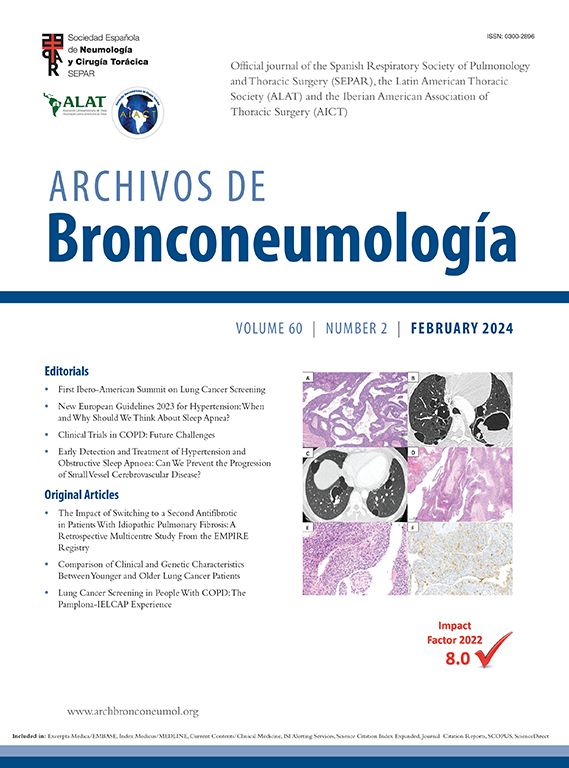Radiomics and Clinical Data for the Diagnosis of Incidental Pulmonary Nodules and Lung Cancer Screening: Radiolung Integrative Predictive Model
IF 9.2
3区 医学
Q1 RESPIRATORY SYSTEM
引用次数: 0
Abstract
Introduction
Early diagnosis of lung cancer (LC) is crucial to improve survival rates. Radiomics models hold promise for enhancing LC diagnosis. This study assesses the impact of integrating a clinical and a radiomic model based on deep learning to predict the malignancy of pulmonary nodules (PN).
Methodology
Prospective cross-sectional study of 97 PNs from 93 patients. Clinical data included epidemiological risk factors and pulmonary function tests. The region of interest of each chest CT containing the PN was analysed. The radiomic model employed a pre-trained convolutional network to extract visual features. From these features, 500 with a positive standard deviation were chosen as inputs for an optimised neural network. The clinical model was estimated by a logistic regression model using clinical data. The malignancy probability from the clinical model was used as the best estimate of the pre-test probability of disease to update the malignancy probability of the radiomic model using a nomogram for Bayes’ theorem.
Results
The radiomic model had a positive predictive value (PPV) of 86%, an accuracy of 79% and an AUC of 0.67. The clinical model identified DLCO, obstruction index and smoking status as the most consistent clinical predictors associated with outcome. Integrating the clinical features into the deep-learning radiomic model achieves a PPV of 94%, an accuracy of 76% and an AUC of 0.80.
Conclusions
Incorporating clinical data into a deep-learning radiomic model improved PN malignancy assessment, boosting predictive performance. This study supports the potential of combined image-based and clinical features to improve LC diagnosis.

用于诊断偶发肺结节和肺癌筛查的放射组学和临床数据:放射肺综合预测模型。
简介肺癌的早期诊断对提高生存率至关重要。放射组学模型有望提高肺癌诊断率。本研究评估了基于深度学习的临床和放射组学模型对预测肺结节(PN)恶性程度的影响:方法:对 93 名患者的 97 个肺结节进行前瞻性横断面研究。临床数据包括流行病学风险因素和肺功能测试。对包含肺结节的每张胸部 CT 的感兴趣区进行分析。放射学模型采用预先训练好的卷积网络来提取视觉特征。从这些特征中选择 500 个标准偏差为正的特征作为优化神经网络的输入。临床模型通过使用临床数据的逻辑回归模型进行估算。临床模型中的恶性肿瘤概率被用作检测前疾病概率的最佳估计值,并利用贝叶斯定理的提名图更新放射线组学模型的恶性肿瘤概率:放射学模型的阳性预测值(PPV)为 86%,准确率为 79%,AUC 为 0.67。临床模型发现,DLCO、阻塞指数和吸烟状况是与预后相关的最一致的临床预测因素。将临床特征整合到深度学习放射学模型中,PPV 为 94%,准确率为 76%,AUC 为 0.80:将临床数据整合到深度学习放射学模型中可改善PN恶性肿瘤评估,提高预测性能。这项研究证明了基于图像和临床特征的组合在改善 LC 诊断方面的潜力。
本文章由计算机程序翻译,如有差异,请以英文原文为准。
求助全文
约1分钟内获得全文
求助全文
来源期刊

Archivos De Bronconeumologia
Medicine-Pulmonary and Respiratory Medicine
CiteScore
3.50
自引率
17.50%
发文量
330
审稿时长
14 days
期刊介绍:
Archivos de Bronconeumologia is a scientific journal that specializes in publishing prospective original research articles focusing on various aspects of respiratory diseases, including epidemiology, pathophysiology, clinical practice, surgery, and basic investigation. Additionally, the journal features other types of articles such as reviews, editorials, special articles of interest to the society and editorial board, scientific letters, letters to the editor, and clinical images. Published monthly, the journal comprises 12 regular issues along with occasional supplements containing articles from different sections.
All manuscripts submitted to the journal undergo rigorous evaluation by the editors and are subjected to expert peer review. The editorial team, led by the Editor and/or an Associate Editor, manages the peer-review process. Archivos de Bronconeumologia is published monthly in English, facilitating broad dissemination of the latest research findings in the field.
 求助内容:
求助内容: 应助结果提醒方式:
应助结果提醒方式:


